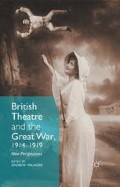Abstract
By 1914 cinema as an art form in its own right had established itself in Britain’s existing complex popular culture, rivalling the theatres and music halls in a way which was beginning to worry them.1 On 20 February 1896 the Lumière brothers had presented a programme of films at the Marlborough Hall on London’s Regent Street. These ‘animated pictures’ were soon incorporated into music hall programmes in London and major cities. By 1899, music hall managers and fairground entertainers were regularly exhibiting films, and in the period 1914–1929 the medium rapidly increased its hold as a socially recognized form of popular entertainment.2 The fledgling film industry utilized techniques common to existing forms of theatrical entertainment: farce, melodrama and mime were key features, and screenings would often share venues with music hall and variety acts. However, it had soon become apparent that a profit could be made from showing films on their own.3 In a number of towns theatres and even skating rinks were transformed into cinemas. In April 1914, for example, the Sadler’s Wells Theatre in Clerkenwell, London, which had also served as a music hall, put on its final stage production and reopened a month later as a ‘picture palace’.4 In this way, cinemas provided continuities of theatrical architecture, décor and related conventions, but film was a distinctly separate medium.5
Access this chapter
Tax calculation will be finalised at checkout
Purchases are for personal use only
Preview
Unable to display preview. Download preview PDF.
Notes
Raymond Williams, ‘British Film History: New Perspectives’, in British Cinema History, eds., James Curran and Vincent Porter (London: Weidenfeld & Nicolson, 1983), 14.
Michael Hammond and Michael Williams eds., British Silent Cinema and the Great War (Basingstoke: Palgrave Macmillan, 2011), 2.
Kenton Bamford, Distorted Images: British National Identity and Film in the 1920s (London: I. B. Tauris, 1999), 3.
Christine Gledhill, Reframing British Cinema 1918–1928: Between Restraint and Passion (London: BFI, 2003), 9.
Nicholas Hiley, ‘The British Cinema Auditorium’, in Film and the First World War, eds. Karel Dibbets and Bert Hogenkamp (Amsterdam: Amsterdam University Press, 1995, 160. The data in the remainder of this paragraph is taken from Hiley.
Dean Rapp, ‘Sex in the Cinema: War, Moral Panic, and the British Film Industry, 1906–1918’, Albion: a Quarterly Journal Concerned with British Studies, 34:3 (2002), 429.
Kristin Thompson, Exporting Entertainment: America in the World Film Market 1907–3, (London: British Film Institute, 1985), ix–x.
Patricia Cook, ‘Albany Ward and the Development of Cinema Exhibition in England’, Film History, 20:3 (2008), 294–307.
Michael Hammond, The Big Show: British Cinema Culture in the Great War 1914–1918 (Exeter: University of Exeter Press, 2006), 2–3.
Nicholas Reeves, ‘Official British Film Propaganda’, in The First World War and Popular Cinema: 1914 to the Present, ed. Michael Paris (Edinburgh: Edinburgh University Press, 1999), 27–50.
Gerard DeGroot, Back in Blighty: the British at Home in World War I (London: Vintage, 2014), 308.
George Creel, How We Advertised America (New York: Harper & Bros., 1920), 274–6.
Bernhard Rieger, Technology and the Culture of Modernity in Britain and Germany 1890–1945 (Cambridge: Cambridge University Press, 2005), 93.
Philip M. Taylor, ‘British Official Attitudes towards Propaganda Abroad’, in Propaganda, Politics & Film, 1918–45, eds., Nicholas Pronay and D. W. Spring (London: Macmillan, 1982), 13–14.
Editor information
Editors and Affiliations
Copyright information
© 2015 Emma Hanna
About this chapter
Cite this chapter
Hanna, E. (2015). British Cinema, Regulation and the War Effort, 1914–1918. In: Maunder, A. (eds) British Theatre and the Great War, 1914–1919. Palgrave Macmillan, London. https://doi.org/10.1057/9781137402004_10
Download citation
DOI: https://doi.org/10.1057/9781137402004_10
Publisher Name: Palgrave Macmillan, London
Print ISBN: 978-1-349-55516-1
Online ISBN: 978-1-137-40200-4
eBook Packages: Palgrave Theatre & Performance CollectionLiterature, Cultural and Media Studies (R0)

